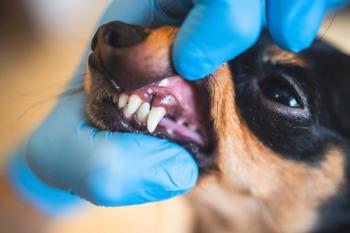
When extraction is not an option: Advanced periodontal therapy (Proceedings)
Treating teeth with periodontal disease is a regular practice at most veterinary clinics.
Treating teeth with periodontal disease is a regular practice at most veterinary clinics. There will be occasions when extraction of a tooth is not an option. Patients that would fit into this category would be young patients where because of their long life expectancy keeping the tooth would be beneficial to the patient and a good investment for the client. Patients that are show dogs where a full dentition is necessary. Then, of course, there are owners that insist that the teeth not be extracted, even when it is not in the patient's best interest. This focus will review on techniques used to treat teeth with moderate to advanced periodontal disease with the object of keeping the tooth.
What is important in these cases is client education. These cases have progressed beyond gingivitis to periodontitis and there may be multiple treatments and extra cost involved.
Goal of Periodontal Therapy
The goal of periodontal therapy is threefold. The first goal is the reduction of periodontal pockets or the elimination of soft tissue or boney lesions. The second goal is to slow or stop the progress of a periodontal lesion. Lastly is to return the tissues to a more normal environment.
Periodontal pockets form due to the apical migration of plaque bacteria causing destruction of soft and boney tissue. Greater than 50% attachment loss carries a guarded to poor prognosis and greater than 75% attachment loss carries a poor prognosis for long term success. It is with professional treatments and rigorous home care that success can be seen.
Flap Surgery
A flap is a section of tissue that has been cut and raised with one side still attached. Flaps are useful because they allow exposure of the root surface while maintaining the attached gingiva and allows the gingiva to be sutured in such a way that the pocket can be reduced.
The objective of flap surgery is to allow adequate access and visibility to the diseased area. When making the flap, the base should be 1 ½ times as wide as the coronal aspect to allow adequate blood flow. The flap needs to be sutured closed in order to prevent displacement, bleeding, hematoma formation and infection.
There are two types of flaps – full thickness and partial thickness. Full thickness flaps are used to gain visibility for boney areas such as root planing and pocket elimination. Using a periosteal elevator, the instrument is placed under the periosteum and rocked until it is peeled away from the bone. Partial thickness leaves the periosteum. This is used in areas where there are thin, bony plates, or in areas where there is dehiscence where bone must be protected or in areas where the bone loss is permanent.
Types of Flap Surgery
Envelope flaps – full thickness flaps that are coronal to the mucogingival line to expose periodontal pockets. If no releasing incision is made, the gingiva can be stretched to allow visualization. The flap should extend to one tooth on either side. When closing, the sutures are placed interdentally.
Release flap - makes the addition of one or two releasing incisions on one or both sides of the lesion. This allows exposure without stretching the gingiva excessively. The horizontal incision is made just below the diseased gingival margin being careful to maintain as much of the attached gingiva as possible. The collarette of diseased gingival margin tissue is removed and the edges of the flap are sutured closed at each releasing incision and interdentally.
Regenerative Therapy
The goal of regenerative therapy is to keep the faster growing alveolar mucosa and gingival connective tissue out of the lesion to allow the growth of the periodontal ligament and bone. Osseopromotive products like Consil (Nutramax, Baltimore, MD) which is a biosynthetic particulate glass material acts as both a barrier and stimulates new bone growth.
In order for regenerative therapy to be successful, all debris and granulation must be removed to clean, healthy bone or tooth surface. Pre and postoperative radiographs should be taken. Removal of any diseased marginal gingiva would also be beneficial. A full thickness flap which includes attached gingiva may be necessary to close the lesion without any tension. Schedule a recheck appointment at 10-14 days with a follow up cleaning, exam and radiographs 3-4 months later.
Periodontal Splinting
When teeth are mobile, it decreases the chances of retention. If the plan is to try regenerative therapy, splinting the teeth may provide stability. This technique can also be used after a traumatic luxation or subluxation of a tooth. The teeth are cleaned and polished and any debris or granulation tissue is removed. The osseopromotive product is placed in the defect and suture closed. A band of dental acrylic is placed around the teeth in the area of the defect with stabile tooth on either side. The acrylic attaches one tooth to another for stabilization.
The splinted area must be cleaned daily using rinses. Regular recheck must follow with a full oral exam with radiographs in 3-4 months.
Conclusion
Successful periodontal therapy requires a close watch by both the hospital staff and the owner. With proper education and training, the hospital staff has the tools they need to provide high quality dental care and be able to give the owner the tools to try their best.
References
Holmstrom, S., Frost Fitch, p., & Eisner, E. (2004). Periodontal therapy and surgery. In Veterinary Dental Techniques for the Small Animal Practitioner, third edition (pp. 233-290). Philadelphia: Saunders.
Lobprise, H., & Wiggs, R. (2000). Periodontal disease. In The Veterinarian's Companion for Common Dental Procedures (pp. 47-62). Lakewood: AAHA Press.
Newsletter
From exam room tips to practice management insights, get trusted veterinary news delivered straight to your inbox—subscribe to dvm360.






